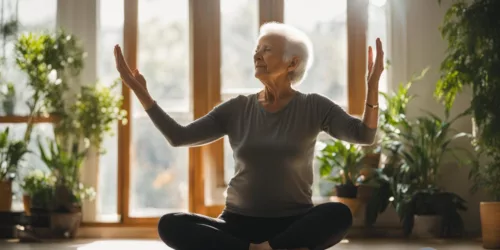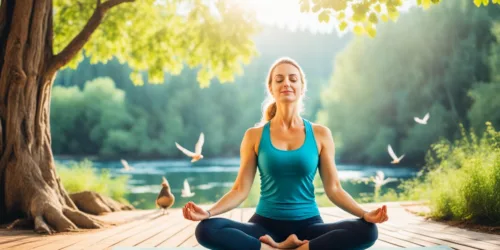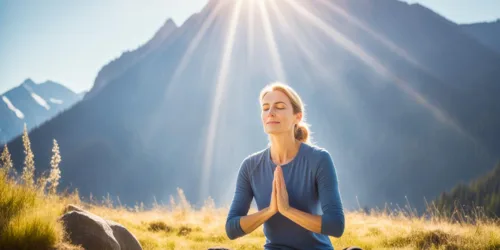Yoga Before or After Walking : Discover The Answer !

We stand at the edge of the beach, the sun just beginning to dip below the horizon, casting its golden light on the waves before us. Taking a deep breath, we feel relaxed and ready to begin.
We know that both yoga and walking can benefit both our physical and mental health, but which should come first?
In this article, we’ll discuss the benefits of both yoga and walking, the best order for intense yoga and walking, and the best time to do yoga if you’re strength training.
Let’s explore the possibilities of combining these two activities for a healthier lifestyle.
Key Takeaways
- Walking before yoga can help settle the mind, clear stray thoughts, and allow for deeper yoga practice.
- Walking after yoga can help ease the mind into the state of external stimuli and provide a gradual transition back to reality.
- Walking may trigger the creative process for some practitioners, both before and after yoga.
- The effects of walking before and after yoga vary from person to person, and it is important to listen to your body and decide what works best for you.
Benefits of Walking Before and After Yoga
We can benefit from walking before and after yoga by improving muscle circulation, preventing injury, and kick starting metabolism.
Walking and yoga go hand in hand as they both contribute to physical and mental health. Walking helps meet aerobic activity goals and improves cardiovascular fitness while yoga strengthens muscles, increases range of motion, and improves balance.
It’s important to pay attention to how walking affects your state of mind before and during yoga practice, as different intensities of walking can increase calorie burn.
Alternating yoga and walking days can maintain an active lifestyle and prevent burnout. Times when walking isn’t needed include intense yoga styles like Ashtanga and Bikram, as rest is needed afterward.
Times When Walking Is Not Needed
We rarely need to walk before or after intense yoga styles like Ashtanga and Bikram, as rest is needed afterwards. It’s best to do yoga after a workout and save intense yoga for rest days. Adding yoga to a warm-up can help with body awareness and a dynamic practice.
Here are some tips for working yoga into a routine:
- Practice yoga after a workout to reduce muscle soreness and DOMS
- Save long holds and deep stretches for cooldown
- Integrate yoga moves into a dynamic warm-up
- Doing a harder yoga class after strength training extends and deepens the work
- Take a rest day to focus on boosting blood flow, mobility, and flexibility
Effects of Walking Before and After Yoga
We’re discussing the effects of walking before and after yoga, and how it can benefit our practice.
Walking before yoga can clear stray thoughts and ease stiffness, while after yoga it helps ease the mind back into reality.
Alternating yoga and walking days can maintain an active lifestyle, while combining them can improve physique, aid in weight loss, and tone muscles.
To maximize results, there should be a time gap between yoga and exercise, and it’s best to start with more intense activity and finish with easier or lighter-intensity.
Yoga before or after walking depends on desired outcomes and personal preferences. Combining yoga and walking for weight loss, with yoga before or after breakfast, can provide great benefits.
Yoga after a workout is best for reducing muscle soreness and DOMS, while yoga before a workout can be part of a dynamic warm-up.
Benefits of Yoga and Walking
Together, yoga and walking can provide many physical and mental health benefits. Both activities are low impact, suitable for all ages and fitness levels. They help reduce the risk of stroke, heart disease, cancer, type 2 diabetes, anxiety, and depression. Moreover, they can improve physique, aid in weight loss, and tone muscles.
When deciding if it’s best to do yoga before or after a workout, here are some tips:
- For maximum benefits, do yoga before or after a workout.
- Create a balanced routine to prevent burnout and allow for muscle recovery.
- Start with more intense activity and finish with easier or lighter-intensity activity.
- Alternate between yoga and walking days to maintain an active lifestyle.
- Choose the order based on desired outcomes and personal preferences.
Fitness From Yoga and Walking
Going for walks and doing yoga regularly can improve our physique, help us lose weight, and tone our muscles.| | |:—:|:—:| |Yoga Poses|Walking Speed| |Heart Rate|Body and Mind| |Muscle Strength| | Yoga poses strengthen muscles, increase range of motion, and improve balance. Walking is a low-impact cardio exercise that boosts heart health and burns calories. Different walking intensities, such as speed walking and incline walking, can increase calorie burn. Through yoga and walking, our body and mind can benefit, with increased muscle strength and improved cardiovascular health. With these improvements, we can transition into the next section, combining yoga and walking.
Combining Yoga and Walking
By combining yoga and walking, we can reap the benefits of both activities and improve our overall fitness. Starting with either yoga or walking, depending on the desired outcome, dynamic stretches and hatha yoga asanas can be alternated with brisk and normal paced walks for variety and benefit.
Balancing routines prevents burnout and allows for muscle recovery. Timing yoga and walking is important; start with more intense activity and finish with easier or lighter-intensity activity.
To maximize the benefits of each session, try walking first to warm-up muscles and improve flexibility, followed by a yoga session for strength-building.
Timing Yoga and Walking
We’re trying to figure out the best timing for combining yoga and walking, so we can get the most out of each activity. Depending on your fitness goals, you may want to start with either yoga or walking.
Stretching and yoga can improve flexibility, while walking can help increase blood flow. For intense yoga styles like Ashtanga or Bikram, rest is more important than walking after, while brisk walking can be beneficial before strength-building yoga.
Alternating yoga and walking days is a great way to maintain an active lifestyle, but it’s important to balance intense yoga styles with calmer ones. Experiment to discover what works best for you!
Order of Intense Yoga and Walking
We’ve been discussing the best order of intense yoga and walking, so we can get the most out of our workout.
For pre-workout yoga, focus on dynamic stretches and avoid long holds and deep stretches.
After an intense yoga session, move into a yin practice, restorative session, or vinyasa or hot yoga.
For rest days, opt for slow yoga to reduce muscle soreness and DOMS.
When integrating yoga with strength training, save yoga for after the workout.
Here are some key points to consider:
- Start with dynamic warm-up stretches before a workout
- Yin yoga, restorative sessions, or vinyasa or hot yoga after an intense yoga session
- Slow yoga on rest days to reduce muscle soreness and DOMS
- Save yoga for after strength training
- Follow a specific plan when integrating yoga with strength training
Frequently Asked Questions
How Often Should I Practice Yoga and Walking?
We recommend practicing yoga and walking regularly for best results. Using symbols and metaphors can help make it more interesting. For those aiming to improve physical and mental health, a combination of both activities is beneficial. Be sure to listen to your body and adjust as needed.
What Are the Best Types of Yoga to Do Before or After a Walk?
We suggest doing a dynamic warm-up before a walk, and a slower, restorative yoga after. This combination will help boost blood flow, loosen tight muscles, and increase mobility. Don’t forget to take rest days and avoid pushing yourself too hard.
Is It Better to Do Yoga Before or After a Workout?
We believe it’s better to do yoga after a workout. Doing yoga before can affect performance, while afterwards it can help reduce muscle soreness. Plus, rest days are the perfect time to enjoy a slower, stretchy practice and boost blood flow.
What Are the Best Yoga Poses to Do on a Rest Day?
On rest days, focus on gentle yoga poses that help boost blood flow, loosen tight muscles, and improve mobility. Slow yoga is best for recovery, avoid intense poses and don’t push yourself. Taking a specific class can be beneficial.
How Can I Integrate Yoga Moves Into My Strength Training Routine?
We can integrate yoga moves into our strength training routine by adding them to our dynamic warm-ups. Afterwards, we can do a harder yoga class to extend and deepen our strength training work. It’s best to follow a specific plan when combining yoga with strength training.
Conclusion
We’ve learned so much about yoga before or after walking and how it can benefit both physical and mental health.
The best order for intense yoga and walking depends on the individual and their fitness goals.
We’ve also found that combining yoga and walking can be an incredibly powerful combination that will have you feeling like you can take on the world in no time!
So don’t wait any longer – get out there and reap the incredible rewards of doing yoga before or after walking today!






